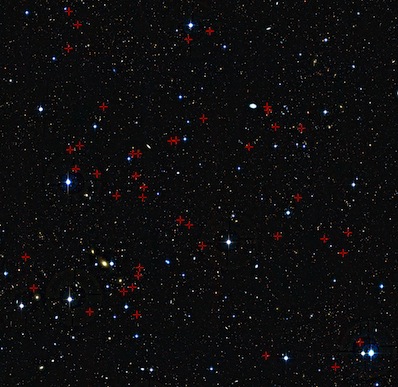
Adolescent galaxies evolve eating habits
DR EMILY BALDWIN
ASTRONOMY NOW
Posted: 14 March 2012


Using ESO's Very Large Telescope (VLT) astronomers have found that 'teenage' galaxies develop a taste for fellow galaxies after spending their childhood years swallowing smooth gas flow.
The study employed the SINFONI instrument (Spectrograph for INtegral Field Observations in the Near Infrared) to focus on galaxy growth between three and five billion years after the big bang, and with over one hundred hours of observing time is the biggest survey of its kind. The results of the so-called MASSIV survey revealed two different phases of galaxy growth as the Universe evolved, from the relatively calm but steady flow of gas onto newly formed galaxies in the young Universe to violent merging events as a large galaxy swallows up a smaller galaxy.

A selection of galaxies (marked by red crosses) in the constellation of Cetus seen as they were between three and five billion years after the big bang as their feeding habits evolved. Image: ESO/CFHT.
"At this particularly turbulent period, similar to the teen years, galaxies are experiencing major transformations," lead author of the study, Thierry Contini tells Astronomy Now. "Smooth gas accretion was efficient to build galaxies when the Universe was 1-2 billion years old because the dark matter halo hosting these galaxies was "cool" enough to allow for the gas to fall directly onto the galaxies. When the Universe was older than five billion years the dark matter halos are "hotter" and it is much more difficult for the gas to feed galaxies directly, adding to the fact the fraction of gas is decreasing with cosmic time. Mergers are at play very early in the history of the Universe, but what we observe with MASSIV is that mergers start to dominate the growing process of galaxies at a cosmic time between 3-5 billion years after the big bang."
Many of the young galaxies in the survey were also found to host heavier elements concentrated in their outer parts, the exact opposite of what is seen in galaxies today. "Indeed, this phenomenon is not observed in nearby and evolved galaxies in which the concentration of metals is much higher in their centre than in their outskirts," says Contini. "The interpretation of this result is not straightforward but it seems that gravitational interactions play a key role. They allow a fast supply of fresh gas in the centre of galaxies, thus diluting their metal content."
The detailed observations also revealed the way in which different parts of the galaxies are moving, and surprisingly some of the galaxies showed no rotation at all. But Contini points out that when little or no velocity shear is observed, it could just be a function of viewing angle. "We do not know if the galaxy is a rotating disc seen face-on, or a spheroid galaxy without rotating motions, or a particular phase of a merger system," he says. Further interpretation would require high resolution images only achievable by the likes of the Hubble Space Telescope, or future generations of telescope such as ALMA (Atacama Large Millimetre/submillimetre Array) and E-ELT (European Extremely Large Telescope).
|



